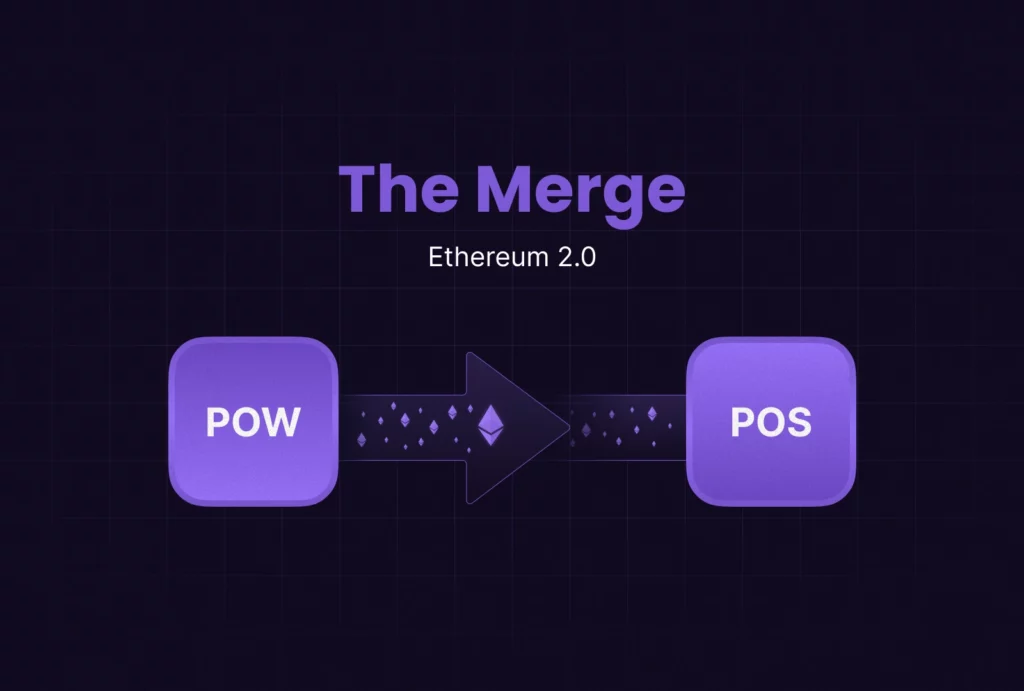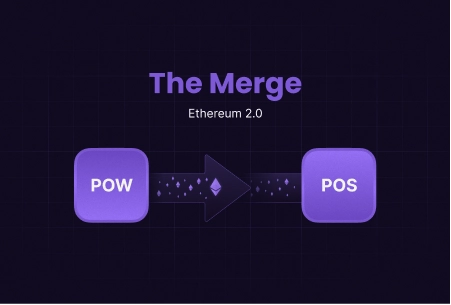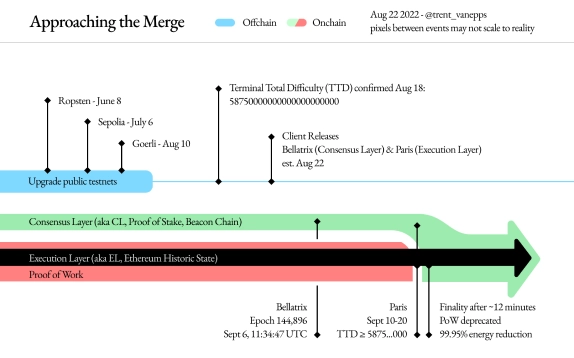What is The Ethereum Merge?


The Merge is quickly approaching. After some delays of the Ethereum Difficulty Bomb, the date is scheduled for mid-September this year, which is only a few days away! The Merge marks the end of the Ethereum Proof of Work which will be replaced by Ethereum 2.0 and the Proof of Stake.
Miners are waiting (or not!) for The Merge. This is an important and historic update for Ethereum that will reduce transaction fee costs while making this cryptocurrency more environmentally friendly.
But what about The Ethereum Merge? What does the future hold for Ethereum miners, especially on Cruxpool?
Why The Ethereum Merge?
After years of work by the Ethereum team, the Proof of Stake upgrade has arrived!
The Merge is not here by chance, and is explained by energy efficiency issues of the Proof of Work, but also for more security.
Having thousands of ultra-powerful machines running all the time consumes energy. It is estimated that the Ethereum blockchain consumes between 94 and 112 TWh of electricity per year, which is equivalent to the electricity consumption of a country like the Netherlands. But with Proof of Stake, the validators, who must block 32 ETH with staking, will be chosen in advance. Thus, the switch to Proof of Stake could reduce Ethereum’s consumption by 99.95%.
In addition, The Merge will increase the security of the network. With the arrival of slashing, the network will be able to remove part of the deposit from bad validators. With Proof of Stake, it is a part of the capital locked in Ether that can go up in smoke if we do not secure more than the Proof of Work blockchain.
Definition : Slashing
Proof of Stake blockchains have both reward and penalty mechanisms.
Good behavior is encouraged by rewards while bad behavior such as inactivity and dishonest validations are subject to a penalty. We refer to this as slashing, the goal of which is to discourage malicious behavior by validators and encourage network participation, security, and node availability.
Slashing varies across protocols. The most common practice involves the loss of a predefined percentage or a fixed amount of a slashing validator’s stake. Some protocols may apply a complete reduction of the stake or remove the validator from the group on a one-time or permanent basis.
But how did Ethereum developers go from Proof of Work to Proof of Stake?
What is the Beacon Chain?
We can not talk about The Merge without introducing the Beacon Chain!
The Beacon Chain served as a test for Ethereum 2.0.
The creation of the Beacon Chain marked the separation of Ethereum between the Proof of Stake blockchain and the Proof of Work blockchain occupied by miners.
The idea of the Beacon Chain was to be able to work freely on the new blockchain without touching the main Proof of Work network.
Today, it is time to merge these two blockchains with The Merge.
The content of the Proof of Work network will be copied on the Beacon Chain in Proof of Stake to complete the migration. We reassure you, all the history is not lost and the funds will be more secure. The Beacon Chain will then be responsible for the verification of the new blocks, but will also ensure the security of the networks by the validation with Ethereum.
On 15 September 2022, Ethereum Proof of Work will become Ethereum Proof of Stake. Namely, users will not have access to funds for about 30 minutes, so be careful!

The Ethereum Merge is coming...
We have said it: The Merge is a crucial update and different from the others.
With The Ethereum Merge, node operators will have to upgrade their consensus layer and execution layer clients at the same time.
Additionally, the upgrade will activate in two phases: the Bellatrix phase at an epoch height on the Beacoin Chain, as well as the Paris phase when a total difficulty value is reached on the execution layer.
To put it simply:
The Merge is therefore divided into two steps.
The first stage is a network upgrade on the consensus layer triggered by an epoch height with Bellatrix.
This is followed by Paris, the transition of the execution layer from Proof of Work to Proof of Stake, triggered by a specific total difficulty threshold called Terminal Total Difficulty.
The Bellatrix upgrade is scheduled for epoch 144896 of the Beacoin Chain, September 6, 2022.
Paris, the execution layer portion of the transition, will be triggered by the Terminal Total Difficulty of 58750000000000000000000, scheduled between September 10 and 20, 2022.
The exact date that the Terminal Total Difficulty is reached depends on the Proof of Work hashrate.
Once the execution layer reaches or exceeds the Terminal Total Difficulty, the next block will be produced by a Beacon Chain validator. The Merge transition is considered complete when the Beacon Chain finalizes this block.
Under normal network conditions, this will happen 2 epochs (equivalent to about 13 minutes) after the first post Terminal Total Difficulty block is produced!
And this will be the highlight of the show!… But what will happen to Ether holders? Ethereum miners?
What will happen after The Ethereum Merge?
Whether you use Ethereum applications on the blockchain, or have Ether on an exchange or crypto wallet, you do not have to do anything.
But beware of scams! If your exchange or crypto wallet offers you instructions or recommendations, take the trouble to check if this information is actually coming from them.
If you are a miner on the main Ethereum Network, you should know that the Ethereum Network will run entirely in Proof of Stake after The Merge. At that time, mining will no longer be possible on the network.
Also, we assume that some cryptocurrencies will inherit the computing power of Ether. Many of us are speculating about Ethereum Classic, the Ethereum fork that needs no introduction! Miners with ASICs on Ethereum are very likely to find themselves mining Ethereum Classic…
This is the end of Ethereum Proof of Work, but not the end of mining! Do not hesitate to mine other Proof of Work cryptocurrencies on Cruxpool like Ethereum Classic, Ergo, Ravencoin or Flux!
Depending on your hardware, it is also very interesting to mine other cryptocurrencies than Ethereum. To get an idea, we invite you to browse our mining performance pages to find out which GPUs are the most optimized for our Proof of Work cryptocurrencies.
We can note and confirm: the transition from Ethereum Proof of Work to Ethereum Proof of Stake is full of twists and turns!
We can’t wait to see what happens at The Merge and we, Cruxpool, will be on the miners’ side to support them.
If you have any questions, please feel free to contact us on the Cruxpool Discord or Telegram. We are here to help you and advise you on the various interesting places to mine.
Happy mining on Cruxpool!
